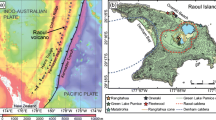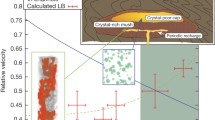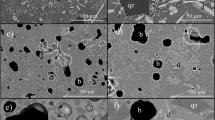Abstract
Bubble coalescence is an important process that strongly affects magmatic degassing. Without coalescence, bubbles remain isolated from one another in the melt, severely limiting gas release. Despite this fact, very little has been done to identify coalescence mechanisms from textures of magmatic rocks or to quantify the dynamics of bubble coalescence in melts. In this paper, we present a systematic study of bubble-coalescence mechanisms and dynamics in natural and experimentally produced bubbly rhyolite magma. We have used a combination of natural observations aided by high-resolution X-ray computed tomography, petrological experiments, and physical models to identify different types of bubble–bubble interaction that lead to coalescence on the timescales of magma ascent and eruption. Our observations and calculations suggest that bubbles most efficiently coalesce when inter-bubble melt walls thin by stretching rather than by melt drainage from between converging bubble walls. Orders of magnitude are more rapid than melt drainage, bubble wall stretching produces walls thin enough that inter-bubble pressure gradients may cause the melt wall to dimple, further enhancing coalescence. To put these results into volcanogical context, we have identified magma ascent conditions where each coalescence mechanism should act, and discuss the physical conditions for preserving coalescence structures in natural pumice. The timescales we propose could improve volcanic eruption models, which currently do not account for bubble coalescence. Although we do not address the effect of shear strain on bubble coalescence, the processes discussed here may operate in several different eruption regimes, including vesiculation of lava domes, post-fragmentation frothing of vulcanian bombs, and bubbling of pyroclasts in conduits.










Similar content being viewed by others
References
Blower JD, Keating JP, Mader HM, Phillips JC (2001a) Inferring volcanic degassing processes from vesicle size distributions. Geophys Res Lett 28:347–350
Blower JD, Mader HM, Wilson SDR (2001b) Coupling of viscous and diffusive controls on bubble growth during explosive volcanic eruptions. Earth Planet Sci Lett 193:47–56
Burgisser A, Gardner JE (2005) Experimental constraints on degassing and permeability in volcanic conduit flow. Bull Volcanol 67:42–56
Caricchi L, Pommier A, Pistone M, Castro J, Burgisser A, Perugini D (2011) Strain-induced magma degassing: insights from simple-shear experiments on bubble bearing melts. Bull Volcanol 73:1245–1257
Castro JM, Dingwell DB (2009) Rapid ascent of rhyolite magma at Chaitén volcano, Chile. Nature 461:780–783
Chan DYC, Klaseboer E, Manica R (2011) Film drainage and coalescence between deformable drops and bubbles. Soft Matter 7:2235–2264
Eichelberger JC (1995) Silicic volcanism: ascent of silicic magmas from crustal reservoirs. Ann Rev Earth Planet Sci 23:41–63
Eichelberger JC, Carrigan CR, Westrich HR, Price RH (1986) Non-explosive silicic volcanism. Nature 323:598–602
Gardner JE, Ketcham RA (2011) Bubble nucleation in rhyolite and dacite melts: temperature dependence of surface tension. Contrib Mineral Petrol 162:929–943
Gonnermann H, Manga M (2007) The fluid mechanics inside a volcano. Ann Rev Fluid Mech 39:321–356
Hess K-U, Dingwell DB (1996) Viscosities of hydrous leucogranitic melts: a non-Arrhenian model. Am Mineral 81:1297–1300
Howell PD (1996) Models for thin viscous sheets. European J Appl Math 7:321–343
Ida MP, Miksis MJ (1995) Dynamics of a lamella in a capillary tube. SIAM J Appl Math 55:23–57
Jaupart C, Allègre C (1991) Gas content, eruption rate and instabilities of eruption in silicic volcanoes. Earth Plan Sci Lett 102:413–429
Ketcham RA (2005) Computational methods for quantitative analysis of three-dimensional features in geological specimens. Geosphere 1:32–41
Klug C, Cashman KV (1996) Permeability development in vesiculating magmas: implications for fragmentation. Bull Volcanol 58:87–100
Kozono T, Koyaguchi T (2009) Effects of relative motion between gas and liquid on 1-dimensional steady flow in silicic volcanic conduits: 2. origin of diversity of eruption styles. J Volcanol Geotherm Res 180:37–49
Lensky NB, Navon O, Lyakhovsky V (2004) Bubble growth during decompression of magma: experimental and theoretical investigation. J Volcanol Geotherm Res 129:7–22
Mangan M, Sisson T (2005) Evolution of melt-vapor surface tension in silicic volcanic systems: experiments with hydrous melts. J Geophys Res 110:B01202
Melnik O, Sparks R (1999) Nonlinear dynamics of lava dome extrusion. Nature 402:37–41
Navon O, Lyakhovsky V (1998) Vesiculation processes in silicic magmas. In: Gilbert JS, Sparks RSJ (eds) The physics of explosive eruptions. Geological Society of London, Special Publications. 145: 27–50.
Okumura S, Nakamura M, Tsuchiyama A (2006) Shear-induced bubble coalescence in rhyolitic melts with low vesicularity. Geophys Res Lett 33:L20316. doi:10.1029/2006GL027347
Proussevitch AA, Sahagian DL (2005) Bubbledrive-1: a numerical model of volcanic eruption mechanisms driven by disequilibrium magma degassing. J Volcanol Geotherm Res 143:89–111
Proussevitch AA, Sahagian DL, Anderson AT (1993) Stability of foams in silicate melts. J Volcanol Geotherm Res 59:161–178
Ribe NM (2001) Bending and stretching of thin viscous sheets. J Fluid Mech 433:135–160
Rust AC, Cashman KV, Wallace PJ (2003) Determining flow type, shear rate and shear stress in magmas from bubble shapes and orientations. J Volcanol Geotherm Res 122:111–132
Slezin YB (2003) The mechanism of volcanic eruptions (a steady state approach). J Volcanol Geotherm Res 122(1-2):7–50
Sparks RSJ (1978) The dynamics of bubble formation and growth in magmas: a review and analysis. J Volcanol Geotherm Res 3:1–37
Toramaru A (1988) Formation of propagation pattern in two-phase flow systems with application to volcanic eruptions. Geophys J 95:613–623
Tuck EO, Stokes YM, Schwartz LW (1997) Slow slumping of a very viscous liquid bridge. J Engineering Math 32:27–40
Tuffen H, Castro JM (2009) The emplacement of an obsidian dyke through thin ice: Hfafntinnuhryggur, Krafla Iceland. J Volcanol Geotherm Res 185:352–366
Valkovska DS, Danov KD, Ivanov IB (1999) Surfactants role on deformation of colliding small bubbles. Colloids Surf A 156:547–566
Vaynblat D, Lister JR, Witelski TP (2001) Rupture of thin viscous films by van der Waals forces: evolution and self-similarity. Phys Fluid 13:1130–1140
Westrich HR, Eichelberger JC (1994) Gas transport and bubble collapse in rhyolitic magma: an experimental approach. Bull Volcanol 56:447–458
Woods AW, Koyaguchi T (1994) Transitions between explosive and effusive eruptions of silicic magmas. Nature 370(6491):641–644
Yoshida S, Koyaguchi T (1999) A new regime of volcanic eruption due to the relative motion between liquid and gas. J Volcanol Geotherm Res 89(1–4):303–315
Acknowledgments
The authors thank J. E. Gardner for experimental samples and discussions. J.M.C. thanks the ISTO and the ERC grant 202844 under the European FP7 for supporting this project. Benoit Cordonnier provided useful comments on an earlier draft. The authors thank A. Proussevitch and an anonymous reviewer who provided comments that greatly improved the manuscript.
Author information
Authors and Affiliations
Corresponding author
Additional information
Editorial responsibility: J. Taddeucci
Appendix
Appendix
Tomography methods
We implemented a number of image processing steps in order to reduce the noise inherent in the μ-CT scans. We performed most of the noise reduction with ImageJ anisotropic diffusion filter and then converted the denoised grayscale images to binary format. We characterized the geometry of the IBFs both qualitatively, by examining the general form of the interfaces throughout given tomographic volumes and by measuring the wavelengths, amplitudes, and thicknesses of the glass wall at the point of maximum deflection between the bubbles. These three-dimensional characteristics were measured on the binary image stacks with Blob3D software, which allows the user to manually select the individual bubbles for geometric characterization. We measured the volume of the dimpled walls using Blob3D, again with the plane tool, which separates the deformed region from the rest of the spherical bubble. These volume measurements slightly overestimate the true volume of the dimple, as the planar section will truncate part of the curve defining the surface of the spherical bubble. The error associated with this separation routine is minor, however, and we estimate that to be less than 0.1 % of the dimple volume and likely 0.01 % of the total bubble volume.
Determination of maximum and average bubble growth rates from VSDs
The decompression experiments of Burgisser and Gardner (2005) were performed on prehydrated and prevesiculated rhyolite glasses. In order to create materials suitable for decompression experiments, they applied a pretreatment involving rapid decompression of the hydrous rhyolite (825 °C and equilibrated at 160 MPa) to a pressure of 100 MPa. This rapid decompression step generated a population of small bubbles that would grow in subsequent experiments according to the applied decompression regimen. We characterized the initial size distribution of this “dwell” population of bubbles with 3D X-ray μ-Tomography, the results of which are presented in Fig. 3. Changes to the bubble population during the different decompression histories were determined by comparing the VSDs in decompression experiments at different rates. Specifically, we measured the difference in the modal and maximum bubble size between the dwell population of the respective decompression runs (Fig. 4). This difference, divided by the experiment duration, yielded the average and maximum bubble growth rates. The resulting rates were used to estimate the magnitude of viscous stress that might arise if two neighboring bubbles grow at different rates.
Rights and permissions
About this article
Cite this article
Castro, J.M., Burgisser, A., Schipper, C.I. et al. Mechanisms of bubble coalescence in silicic magmas. Bull Volcanol 74, 2339–2352 (2012). https://doi.org/10.1007/s00445-012-0666-1
Received:
Accepted:
Published:
Issue Date:
DOI: https://doi.org/10.1007/s00445-012-0666-1




